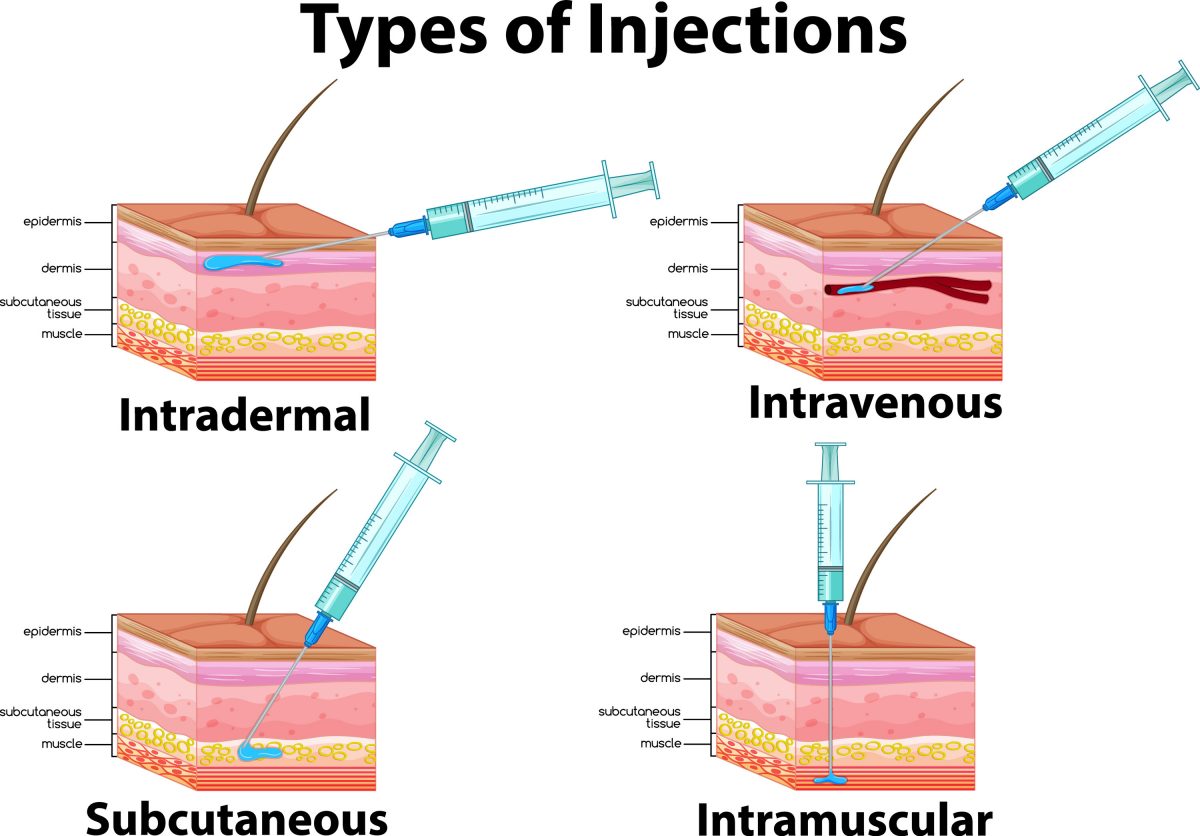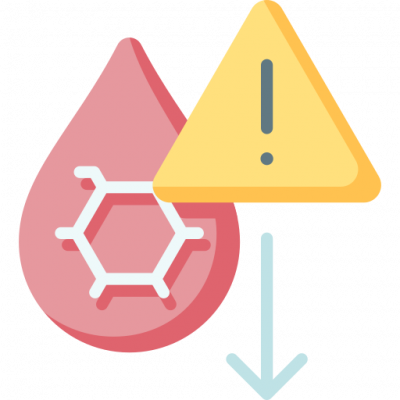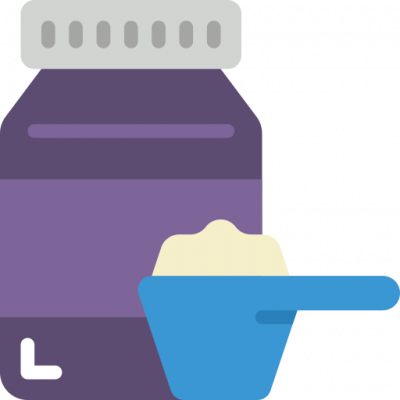INTRODUCTION
It’s been a stressful week for Lance. Lance Sugarman, a 49-year-old male with a history of poorly-controlled type 2 diabetes (T2D), arrives at the emergency department (ED) with complaints of abdominal pain, pain and burning while urinating, and severe dehydration. Connie—his wife—shares with staff that he has become increasingly confused and disoriented over the last three days. In the ED, Lance discloses that he recently lost his health insurance coverage. As a result, he began to ration his insulin glargine by taking less than his prescribed amount (10 units once daily). His last dose was four days ago. Paramedics report that the patient has a peculiar, fruity smell. Point-of-care (POC) testing also notes several laboratory abnormalities (see Table 1). Based on these laboratory results and the patient’s presentation, Lance is admitted to the intensive care unit (ICU). Most importantly, the team has a diagnosis in mind and is prepared to initiate therapy.
| Table 1. Lance Sugarman’s (MR1234567) Laboratory Findings |
| Test |
Results (normal range) |
| Blood glucose |
442 mg/dL (70-110 mg/dL) |
| Venous pH |
6.72 (7.31-7.41) |
| Urine ketone strip |
4+ (< 2+)* |
| β-hydroxybutyrate |
5.2 mmol/L (< 0.5 mmol/L) |
| Serum bicarbonate |
12 mmol/L (21-28 mmol/L) |
| Serum osmolality |
282 mOsm/kg (275-295 mOsm/kg) |
| Serum potassium |
3.1 mmol/L (3.5-5.0 mmol/L) |
| *A urine ketone of less than 2+ is consistent with the absence of ketosis or the presence of mild ketosis, which is considered normal. |
PAUSE AND PONDER: What laboratory markers are you concerned about? What would be a part of your differential diagnosis?
Clearly, Lance’s blood glucose (BG) is dangerously elevated. Hyperglycemic crises—an umbrella term for diabetic ketoacidosis (DKA) and hyperosmolar hyperglycemic state (HHS)—are life-threatening medical emergencies associated with uncontrolled diabetes mellitus (DM).1 Since 2009, hospital admission rates in the United States (U.S.) for DKA and HHS have increased, and this trend is present globally as well.2,3 Increasing rates of DKA and HHS can be attributed to higher medication costs, particularly insulin, and the rise in DM incidence, which increased from 200 million cases in 1990 to 830 million cases in 2021.3,4
Patients with DKA and HHS present with severe hyperglycemia (elevated BG).5 HHS has markedly higher BG levels than DKA; BG levels can reach 600 mg/dL in DKA compared to 1,000 mg/dL in HHS.5,6 Each diabetic emergency has specific defining criteria outside of hyperglycemia. DKA is characterized by an increased concentration of ketone bodies (metabolites of fatty acids) in the blood or urine and metabolic acidosis (a buildup of acid in the body).5,7 HHS, on the other hand, is defined by hyperosmolarity (a higher than normal concentration of dissolved substances in the blood or other bodily fluid) and the absence of ketoacidosis (a buildup of ketones in the body).6
Many signs and symptoms of DKA and HHS overlap, such as dehydration in the setting of an elevated BG, making the clinical work-up and distinction difficult.6 To make matters more difficult, 27% of hospital admissions for hyperglycemic crises are for a mixed DKA-HHS presentation.5 Patients with a mixed DKA-HHS presentation have both ketoacidosis and hyperosmolarity.8 For the sake of simplicity, this continuing education will focus on DKA and HHS as separate entities. The interdisciplinary team should, however, be aware that mixed DKA-HHS exists. It is critical that the healthcare team—including pharmacists and pharmacy technicians—possesses the knowledge to differentiate between DKA and HHS to appropriately treat and manage patients.
BACKGROUND
Prevalence and Risk Factors
DKA and HHS make up approximately 1% of all hospitalizations in people with DM; hospital admission rates have increased by 55% over the last decade. 5,9 DKA and HHS are complications of DM, but they do not occur at the same rate in both type 1 diabetes (T1D) and T2D. Prevalence of hyperglycemic crises in the U.S. is higher in patients with T1D (44.5 per 1,000 person-years) compared to patients with T2D (3.2 per 1,000 person-years).10 Moreover, DKA occurs most often in those aged 18 to 44 years with T1D compared to HHS, which commonly impacts an older subset of patients aged 45 to 64 years with T2D.5 Interestingly, DKA is the initial presentation—the clue that an undiagnosed patient has T1D—for around 6% to 21% of patients with T1D.5
Increasing technological advancements for monitoring BG and managing insulin regimens may be associated with decreased incidence or prompt recognition of hyperglycemic crises.5 Additionally, accurate monitoring helps prevent recurrent episodes.5 However, real-world data to corroborate this idea is still needed. The SIDEBAR discusses options for BG monitoring.
SIDEBAR: Sweet Surveillance5,11-17
Early detection of DKA and HHS—via warning signs and urine or blood checks—allows patients or clinicians to start preventive measures or treatment promptly. The American Diabetes Association and European Association for the Study of Diabetes (ADA/EASD) recommend patients with T1D use a continuous glucose monitor (CGM) as the monitoring method of choice; patients with T2D may also use CGM.
CGMs are automated devices that can continuously estimate a patient’s glucose level at any time. With three parts—a small sensor inserted into the skin, a transmitter, and a receiver (which is often a SmartPhone)—a CGM provides real-time updates, allowing patients to take preventive measures for hypo- or hyper-glycemia. A blood glucose meter (BGM), on the other hand, is not inserted into the skin. Instead, a BGM uses blood samples collected from fingerstick devices (known as lancing devices or lancets) to calculate BG. CGMs, however, are often preferred due to portability and, thus, convenience.
Other tests to consider for DKA, specifically, are ketone concentration tests. Ketones can be measured by urine dipsticks (which measure acetoacetic acid) or blood samples (which measure β-hydroxybutyrate, the predominant ketone in DKA). Blood ketones provide real-time measurements. Urine ketones, instead, lag the concentration of blood ketones due to the shift of acetoacetic acid to β-hydroxybutyrate that occurs during early DKA. Thus, urine ketones may underestimate a patient’s current level of ketonemia (presence of ketone bodies in the blood) and are not preferred for diagnosing or monitoring DKA.
Testing for BG and/or ketones allows patients to contact their providers or an emergency call service in a timely manner; this, according to the Centers for Disease Control and Prevention and ADA/EASD, can reduce DKA or HHS admissions.
Mortality is higher among those with HHS compared to DKA (5% to 20% compared to less than 1%, respectively).18,19 Several factors are attributed to HHS’s higher degree of mortality, including precipitating factors, age, and complications. Vascular complications, such as stroke or peripheral arterial and venous thrombosis, contribute to HHS’s high mortality rate.20
Pathophysiology
In the U.S., 38 million (or one in 10) adults have DM, a group of metabolic diseases resulting from defects in insulin’s action, secretion, or both.21,22 Insulin’s major action is reducing BG levels by driving glucose into cells.23 When insulin becomes dysregulated (i.e., in DM), a patient’s blood sugar may rise. An elevated blood glucose is referred to as hyperglycemia. Though both T1D and T2D can lead to hyperglycemia, the preceding mechanism is different. To explain simply24,25
- T1D is caused by the autoimmune destruction of β cells in the pancreas, leading to insufficient insulin secretion or absolute insulin deficiency.
- T2D is caused by a non-immune mediated process resulting in insulin resistance (or the body’s lack of response to insulin) which, over several years, may lead to relative insulin deficiency.
Insulin dysregulation leads not only to the development of diabetes, but to the development of hyperglycemic crises.
Insulin insufficiency and an increase in counterregulatory hormones—including cortisol, epinephrine, glucagon, growth hormone—are hallmarks of both types of hyperglycemic crises. The degree of the insulin deficit, however, plays a role in distinguishing between DKA and HHS; DKA is characterized by severe insulin deficiency compared to HHS, where less severe insulin deficiency is present.5
Glucagon is the primary counterregulatory hormone in DKA. It should be known, however, glucagon alteration is not essential for DKA to develop.5,7 In DKA, changes to the glucagon-to-insulin ratio can lead to alterations in glucose synthesis, regulation, and utilization, resulting in hyperglycemia.5 Simultaneously, the severe insulin deficiency in DKA, along with the irregular counterregulatory hormones, results in release of free fatty acids (FFAs). Excess FFAs are oxidized to ketone bodies—acetone, acetoacetate, and β-hydroxybutyrate—leading to ketonemia and metabolic acidosis.5,7,19
Ketoacidosis does not occur in HHS. Unlike DKA, sufficient insulin is present in patients with HHS, which prevents ketoacidosis from developing.5 Glucose production and use in the patient’s body, however, is still impacted, leading to hyperglycemia.5 HHS is also characterized by osmotic diuresis. Osmotic diuresis is increased urination due to the presence of certain substances (i.e., glucose) in the fluid filtered by the kidneys, creating a pressure imbalance between solutes and water in the kidneys. This process prevents water reabsorption and, instead, promotes water excretion in the form of urine. Osmotic diuresis occurs from reduced fluid intake (often caused by a precipitating event) and leads to HHS’s characteristic hyperosmolar state alongside severe dehydration and cognitive impairment.5,7,18
PAUSE AND PONDER: What risk factors might you consider red flags for identifying these hyperglycemic crises in your pharmacy setting?
Precipitating Events and Risk Factors
Patients with DM present with hyperglycemic crises for several reasons, including5,7
- difficulties in managing insulin therapy, such as omission or non-adherence
- metabolic stress
- intercurrent illness (a disease that occurs during the course of another disease) or infection
Challenges with therapy management is the most common cause of a hyperglycemic crisis in the U.S. (41% to 59.6% of patients). Worldwide, however, the predominant precipitating factor of a hyperglycemic crisis (occurring in 14% to 58% of cases) is intercurrent illness or infection. Common infectious causes include pneumonia and urinary tract infections (UTIs).7,26
Several clinical and non-clinical factors put patients at risk for hyperglycemic crises. General risk factors for both DKA and HHS include5,9,26
- socioeconomic status (e.g., low income, low educational achievement)
- history of previous hypo- or hyper-glycemic crises
- comorbid chronic health or behavioral health conditions, such as DM-related conditions (e.g., neuropathy), kidney disease, eating disorders, and depression
- alcohol and/or substance use
- certain medications, such as sodium-glucose cotransporter-2 inhibitors (SGLT2i; e.g., canagliflozin, dapagliflozin, empagliflozin) and anti-psychotics (e.g., clozapine, olanzapine, quetiapine, risperidone)
- elevated hemoglobin A1c (HbA1c)
Understanding risk factors and events that may trigger hyperglycemic crises is important for preventing both DKA and HHS. Counseling is important in these patient populations, specifically regarding monitoring (e.g., signs, symptoms, ketones, and BG) and self-management.9
CLINICAL PRESENTATION AND DIAGNOSIS
Signs and Symptoms of DKA and HHS
With both crises, patients may present with a variety of symptoms, with some overlapping. The differences in presentation, outlined in Table 2, can help pharmacy technicians determine when an individual may require pharmacist intervention and guide pharmacists to recommend appropriate treatment.
| Table 2. Characteristic Features of DKA and HHS5,7,20,27,28 |
| |
DKA |
HHS |
| Epidemiology |
· T1D
· Younger |
· T2D
· Older |
| Onset |
· Rapid, hours to days |
· Slow, days to a week |
| Cognitive function |
· Mild-to-moderate confusion |
· Severe confusion, seizures, or coma |
| Compensation |
· Kussmaul respirations |
· None |
| Symptoms |
· Abdominal pain
· Mild dehydration
· Mild weight loss
· Nausea
· Polydipsia
· Polyuria
· Vomiting |
· Higher degree of dehydration
· Higher degree of weight loss
· Polydipsia
· Polyuria |
| Additional signs |
· Tachycardia
· Tachypnea |
· Poor skin turgor |
| ABBREVIATIONS: DKA, diabetic ketoacidosis; HHS, hyperosmolar hyperglycemic state; T1D, type 1 diabetes; T2D, type 2 diabetes |
When any patient presents with typical symptoms of hyperglycemia, such as polydipsia (excessive thirst), polyuria (excessive urination), and a change in cognitive state, clinicians should consider DKA or HHS in their differential diagnosis.9 However, it is important to be aware that not all patients present with these common signs; for example, patients with euglycemic DKA secondary to SGLT2i therapy often present with less polyuria and polydipsia.7 The SIDEBAR provides more information on euglycemic DKA.
Kussmaul respirations—a pattern of deep breathing and hyperventilation accompanied by a fruity odor—is a manifestation specific to DKA.5,29 As previously discussed, patients with DKA have ketoacidosis, unlike HHS. Kussmaul respirations are the body’s compensatory response to the metabolic acidosis present during DKA as an attempt to normalize the disrupted acid-base balance.30
SIDEBAR: Sweet Lies: Euglycemic DKA5,9,31,32
DKA is a common complication of DM characterized by ketonemia, metabolic acidosis, and hyperglycemia (serum glucose at or exceeding 200 mg/dL [11.1 mmol/L]). However, 10% of patients present with an uncommon complication of DM and presentation of DKA—euglycemic DKA. Euglycemic DKA occurs without hyperglycemia but rather euglycemia (normal serum glucose of 200 mg/dL [11.1 mmol/L] or less). (PRO TIP: the prefix “eu-” means good or well, and in medicine is often used to mean “normal.”) Patients with euglycemic DKA, like DKA and HHS, have an insulin deficiency.
Without clear signs of hyperglycemia present (e.g., polydipsia, polyuria), diagnosis or treatment may be delayed. Patients presenting with euglycemic DKA, therefore, are at risk of increased mortality and morbidity. Common causes of euglycemic DKA include
- alcohol use
- exogenous insulin injection
- liver failure
- pregnancy
- SGLT2i therapy
- starvation
Of these, SGLT2i therapy accounts for the greatest number of euglycemic DKA cases. Cases of euglycemic DKA have continued to increase over the last couple of years. This has resulted in changes to the guideline recommendations for diagnosing DKA. The ADA/EASD, Joint British Diabetes Societies for Inpatient Care (JBDS), American Association of Clinical Endocrinology (AACE), and Diabetes Technology Society (DTS) recommend diagnosing DKA with either a blood glucose of greater than 200 mg/dL (11.1 mmol/L; previously 250 mg/dL [13.9 mmol/L]) or any BG level in a patient who presents with a history of DM.
DKA and HHS Diagnosis
Hiding is not their forte; DKA and HHS give their diagnostic criteria away immediately! Literally. It’s in their names. According to the ADA/EASD/JBDS/AACE/DTS Hyperglycemic Crises in Adults with Diabetes Consensus Report, clinicians diagnose DKA based on the presence of all three of the following criteria5,9:
- Diabetes/Hyperglycemia: an elevated BG level OR a prior history of DM regardless of BG level
- Ketonemia: an elevated ketone body concentration in the blood OR urine
- Acidosis: a diminished venous pH AND/OR reduced serum bicarbonate level
Clinicians diagnose HHS based on the presence of all three of the following criteria:
- Hyperosmolality: an elevated calculated effective or total serum osmolality
- Hyperglycemia: an elevated BG level
- AbSence of ketonemia (ketone body concentration is not elevated in the blood OR urine) AND acidosis (venous pH AND serum bicarbonate are within normal limits)
Table 3 lists laboratory markers mentioned in the diagnostic criteria for DKA and HHS. Upon reviewing Table 3, revisit Lance’s laboratory findings (see Table 1) and his clinical picture to determine his diagnosis. His BG clearly demonstrates a hyperglycemic crisis, and these two types are related but not the same.
| Table 3. Laboratory Markers for Diagnosis of DKA and HHS5 |
| Laboratory marker |
DKA |
HHS |
| Glucose |
≥ 200 mg/dL (11.1 mmol/L)
OR
history of DM |
≥ 600 mg/dL (33.3 mmol/L) |
| BHB concentration
|
≥ 3.0 mmol/L
OR
urine ketone strip ≥ 2+ |
< 3.0 mmol/L
OR
urine ketone strip < 2+ |
| Urine ketone strip |
| Venous pH |
pH < 7.3
AND/OR
< 18 mmol/L |
pH ≥ 7.3
AND
≥ 15 mmol/L |
| Serum bicarbonate |
| Serum osmolality |
NA |
> 300 mOsm/kg (calculated effective)
OR
> 320 mOsm/kg (total) |
ABBREVIATIONS: BHB, β-hydroxybutyrate; DKA, diabetic ketoacidosis; DM, diabetes mellitus; HHS, hyperosmolar hyperglycemic state
Patients and clinicians can measure ketone body concentrations using several methods, including urine, serum, and blood testing. Urine and serum testing measures concentration of acetoacetic acid while blood testing quantifies the concentration of β-hydroxybutyrate, which is preferred due to higher specificity for DKA.5 The patient care team should also acknowledge the potential overlaps in presentation. Clinicians diagnose HHS based on the absence of metabolic acidosis, indicated by normal venous pH and bicarbonate levels, and the absence of ketonemia, shown by low β-hydroxybutyrate or negative urine ketones. However, patients with HHS may have mild ketonemia due to modest ketone production, though ketone levels are generally much lower than in DKA.18 Similarly, patients with HHS may have mild metabolic acidosis resulting from dehydration secondary to the hyperosmolar state, as reduced volume promotes lactic acid production that disrupts the acid-base balance.18
Given his combination of laboratory abnormalities and clinical presentation (i.e., signs and symptoms), Lance from the patient case presented is experiencing a classic episode of DKA.
Patients suspected of having DKA or HHS must be referred for emergency evaluation, treatment, and a thorough work-up.7 All work-ups should evaluate vital signs and laboratory findings to not only confirm a hyperglycemic crises, but also to narrow down a precipitating event and anticipate complications.5,18,26 Outside of the parameters listed in Table 3, clinicians must measure blood electrolyte levels and perform an electrocardiogram.5 If an infection is the suspected precipitating cause, the ADA/EASD/JBDS/AACE/DTS recommends a urinalysis (urine test) and/or chest X-ray to identify and/or diagnose a UTI or pneumonia, respectively.5,18 Based on lab results, patient history, and final diagnosis, clinicians initiate disease-specific therapy.
Remember the pain and burning sensation Lance reported in the ED? His physician ordered a urinalysis, which found elevated bacteriuria (bacteria in the urine), and a urine culture, which was found to be positive and growing Escherichia coli. Turns out he has a UTI! With this information, the team is prepared to initiate appropriate antibiotics and prepare for complications of UTIs or DKA. This infection is what likely exacerbated his DM and led to this episode of DKA.
TREATMENT OF DKA AND HHS
Goals of Therapy
DKA and HHS share several features, including some aspects of treatment and therapeutic goals. Successfully treating hyperglycemic crises requires the following5,33:
- correction of dehydration
- correction of hyperglycemia
- correction of electrolyte imbalance(s)
- identification and treatment of precipitating event(s)
PAUSE AND PONDER: What medications can be used to lower blood sugar? Which should you use first in a hyperglycemic crisis?
Dehydration
Intravenous (IV) fluids are first-line therapy for DKA and HHS.7,34 Treatment with IV fluids restores intravascular volume to perfuse organs and tissue, correct electrolyte abnormalities, and resolve metabolic acidosis and ketogenesis.5,7,35 Correcting the fluid deficit aids in decreasing BG and regulating counterregulatory hormone levels.34
The ADA/EASD/JBDS/AACE/DTS recommend isotonic saline—also known as 0.9% sodium chloride (NaCl) or normal saline (NS)—as the fluid of choice for patients without renal or cardiac compromise.5 Use of a balanced crystalloid (e.g., lactated ringers [LR]), however, is an acceptable choice.5 During the first two to four hours, the administration rate is 500 to 1,000 mL/hour.5 Subsequent fluid replacement (i.e., 0.45% or 0.9% NS) and administration rate is based on hemodynamic stability and the patient’s fluid status.5,7
Balanced crystalloids contain sodium, potassium, and chloride content resembling that of normal extracellular fluid and cause fewer adverse effects on acid-base balance compared to NS.5,36 A recent systematic review and meta-analysis of eight randomized controlled trials involving 482 patients found that LR shortened the time to DKA resolution and length of hospital stay.36 Patients treated with NS required 3.51 additional hours to recover from DKA and remained hospitalized for nearly an additional day (specifically, 0.89 days).36 LR may decrease costs for patients but may increase costs for hospitals. One liter of LR typically costs more than twice that of one liter of NS, with one source indicating they cost $4.50 and $2, respectively.37 While research suggests LR resolves hyperglycemic emergencies faster, the patient-care team and hospital’s procurement team must weigh the potential increase in clinical benefits against the increase in cost. Therefore, the ADA/EASD/JBDS/AACE/DTS guidelines recommend physicians choose IV fluids based on availability, cost, and patient-specific information.5
Fluid therapy decreases BG—slowly, but surely. In DKA, for example, a patient’s BG can fall to less than 250 mg/dL in four to eight hours.5 Using concomitant insulin compounds the reduction. If not closely monitored, patients become at risk of having a hypoglycemic (low BG) episode. As a result, 5% or 10% dextrose is a recommended addition to the fluid regimen once BG falls to less than 250 mg/dL to maintain BG and allow for ketoacidosis to resolve.5,38
Hyperglycemia
Acute Management
Insulin, like fluid management, decreases BG and regulates ketogenesis.35 However, patients undergoing hyperglycemic crises should never receive insulin in place of or before fluid therapy. Insulin administration shifts fluids from the intravascular space into the cells, which can exacerbate hypovolemia (decreased blood volume) and lead to severe hypotension (decreased blood pressure).39 For this reason, insulin is recommended following initial fluid resusicitation.39
Short-acting, IV insulin (e.g., insulin regular [Humulin R, Novolin R]) is the cornerstone of DKA and HHS management and prescribers should start IV insulin as soon as a patient is diagnosed and adequately hydrated.5 Rapid-acting insulin (e.g., insulin lispro [Humalog]) is considered for the treatment of mild or moderate DKA but not HHS.5,19
The continuous insulin infusion rate used in DKA depends on a facility’s protocols and the severity of the patient’s condition. Preferred options include a fixed-rate starting at 0.1 units/kg/hour or a nurse-driven protocol (variable rates).5 Nurse-driven protocols and algorithms allow nurses to adjust treatment based on laboratory results. Different providers might choose different rates or fluids to treat patients, while a nurse-driven protocol makes sure all patients receive all the same guideline-driven medications, unless otherwise contraindicated.40 If obtaining venous access is delayed for any reason, it is recommended to initiate an intramuscular (IM) bolus dose (0.1 units/kg) of insulin.33
HHS treatment depends on the presence of ketosis (metabolic state in which the body burns fat for energy), ketonemia, and acidosis. The ADA/EASD/JBDS/AACE/DTS recommends initiating insulin at 0.05 units/kg/hour in patients with HHS, no ketosis or mild-to-moderate ketonemia, and no acidosis.5
Regardless of the crisis or regimen chosen, the insulin rate requires adjustment—like with fluid replacement—once BG falls below 250 mg/dL.5,34 Insulin’s rate should be corrected (based on institution specific protocols) to maintain BG at 150 to 200 mg/dL in DKA or 200 to 250 mg/dL in HHS until resolution (to be discussed later) of either crisis.5
Maintenance Insulin Therapy
Following resolution of DKA or HHS and when patients can tolerate food and drink, they should transition from IV to subcutaneous insulin. During this transition period, patients are at an increased risk of hyperglycemia, ketoacidosis, and recurrent DKA or HHS.5,18 IV insulin’s half-life is short, around less than 10 minutes.41 Thus, to prevent these complications, an overlap between discontinuation of IV insulin and the initiation of subcutaneous insulin must occur over one to two hours.5,33
The treatment team designs the patient’s subcutaneous insulin regimen based on current clinical situation, previous insulin use, and assessment of insulin requirements.41 The ADA/EASD/JBDS/AACE/DTS recommends that patients with known DM and previous insulin use receive their at-home regimen.5 For patients without known DM or prior insulin use, various methods are available to estimate total daily dose (TDD) of insulin. No consensus on a preferred method is available, but approaches often used include5,41
- Weight-based calculation: 0.5 to 0.6 units/kg/day for insulin-naive patients; 0.3 units/kg/day for patients with risk factors for hypoglycemia, such as kidney failure
- Pre-admission insulin requirements: for patients with history of insulin use prior to hospital admission, consider previous TDD of insulin and evaluate outpatient HbA1c levels
- Hourly inpatient IV insulin requirements: uses the patient’s current in-hospital summation of hourly IV insulin requirements; evaluate a several-hour period (typically six-to-eight hours) during which the patient’s BG remains at goal and the IV insulin rate is stable
With TDD calculated, it is time to choose an appropriate insulin regimen. Insulin regimens should be dosed properly to ensure 24-hour coverage.5,41 Additionally, certain insulin types are preferred over others. The ADA/EASD/JBDS/AACE/DTS recommended therapy is a basal-bolus (basal and rapid-acting) insulin regimen, as it is closely mimics physiologic state and reduces hypoglycemia risk.5 Short-acting insulin regimens are an acceptable alternative, but they may require a change in frequency (i.e., from once daily to twice daily) to ensure adequate coverage.5 SGLT2is should not be initiated or continued in a hospitalized patient.5 Non-insulin agents—excluding SGLT2is—may be considered in a patient with T2D undergoing insulin therapy or if they are ketosis-prone. Non-insulin agents are contraindicated in patients with T1D.5
Electrolyte Imbalances
Electrolyte disorders—most commonly of potassium—occur in both DKA and HHS. Potassium-associated disorders may result from osmotic diuresis (in HHS) or metabolic acidosis (in DKA).5,18 Patients may present with low potassium (hypokalemia), normal potassium, or high potassium (hyperkalemia). One-third of patients arrive to the hospital in a hyperkalemic state, while the remaining patients typically present with normal potassium levels.42 (Potassium will decline within 48 hours of initiating treatment for DKA or HHS, like insulin therapy, so additional treatments for hyperkalemia are not required.5)
A small proportion of patients—5% to 10%—have low potassium (less than 3.5 mmol/L) at admission.5 In this population, insulin initiation should be delayed. Insulin’s purpose in DKA and HHS management is to decrease BG. However, insulin also stimulates the movement of potassium into the cells, which may result in hypokalemia during infusion.5,18 Potassium replacement is initiated at 10 mmol/hour in individuals with hypokalemia.5 Once serum potassium is greater than 3.5 mmol/L, insulin infusion can begin.
During DKA or HHS management, potassium serum levels are maintained at a goal level of 4 to 5 mmol/L.5 (Potassium is often presented in mEq/L; 1 mmol/L of potassium is equal to 1 mEq/L of potassium.) If not monitored and maintained at goal, hypokalemia may develop in 55% of patients undergoing insulin and fluid therapy.5,43 Without replenishment, patients are at risk of life-threatening arrythmias, myocardial infarction, and respiratory muscle weakness.18,42
Upon treatment initiation with fluids and insulin, potassium levels will begin to decrease.5 If the team fails to monitor hyperkalemic patients closely, they may develop hypokalemia. Potassium replacement (20 to 30 mmol/L of potassium) is appropriate to add to IV fluids if the serum potassium level falls to 5 mmol/L or less.5,18
Other electrolyte disorders—such as hypomagnesemia (low magnesium), hypophosphatemia (low phosphates), bicarbonate irregularities—are not regularly monitored or treated. It is important, however, to know when repletion is indicated and the available treatment options.5,18,39,42
Hypophosphatemia results from an extracellular shift of phosphate. Severe hypophosphatemia may lead to decreased cardiac function, respiratory failure, rhabdomyolysis, and more.5,26 Phosphate therapy, however, is not indicated in all patients due to risk of hypocalcemia (low calcium) and hypomagnesmia.18,26 Patients with DKA and a phosphate level of less than 1 mg/dL or with evidence of muscle weakness (i.e., respiratory or cardiac compromise) are indicated for phosphate replacement.5,18 Information concerning phosphate replacement for patients with HHS is limited and often extrapolated from data for DKA. The ADA/EASD/JBDS/AACE/DTS recommends using a similar approach in patients with both DKA and HHS.5,18 If indicated, replacement fluids may be enhanced with 20 to 30 mmol of potassium phosphate.5
Low serum levels of bicarbonate are a root cause of metabolic acidosis in DKA. Bicarbonate administration is not typically recommended, however, unless the patient develops severe metabolic acidosis or severe hyperkalemia with a decrease in cardiac function.5,26 Severe metabolic acidosis is defined as a venous pH less than 7.0.5 Clinicians may administer 100 mmol of sodium bicarbonate (8.4% solution) in 400 mL of sterile water every 2 hours to replenish bicarbonate until pH is greater than 7.0.5
Magnesium abnormalities may appear in DKA and HHS but are not commonly treated. Hypomagnesemia may result in arrythmias, which can lead to Torsade’s de Pointes (a life-threatening rapid, abnormal heart rhythm), muscle weakness, and convulsions.18,39 The ADA/EASD/JBDS/AACE/DTS do not provide a recommendation for magnesium replacement initiation or regimen. The American Academy of Family Physicians recommends starting replacement therapy if magnesium levels are less than 1.2 mg/dL, but they do not provide a treatment regimen.26
Returning to the case, Lance’s care team ordered an initial bolus of 1,000 mL/hour of 0.9% NS. After two hours, the team decides to reorder a POC glucose and electrolyte panel, resulting in a glucose drop to 309 mg/dL. Though this is a great initial reduction, Lance is still not at goal. Lance’s physician orders 9.38 units/hour of insulin regular. The pharmacist, however, denies the order. At first the physician believes the order is wrong (it is not; to check yourself, use the patient weight: 93.8 kg). But the pharmacist explains that insulin is currently not indicated since the patient’s electrolyte panel still shows hypokalemia (3.1 mmol/L). Grateful to the pharmacist for a great catch, the physician, instead, orders a potassium replacement regimen. The physician will add insulin to Lance’s regimen once indicated.
ONGOING MANAGEMENT OF DKA AND HHS
Monitoring
Patients undergoing treatment for DKA or HHS require continuous monitoring until either crisis is resolved.5 Monitoring allows clinicians to assess treatment responses, adjust treatment regimens, and prevent possible complications.
Monitoring parameters to be reviewed during the treatment of DKA and HHS include5,18,26
- serum BG, every hour
- electrolytes (i.e., potassium, sodium), β-hydroxybutyrate, phosphate, renal function (serum creatinine), and venous pH, every two to four hours
- serum osmolality (only in HHS), every two to four hours
Resolution
The criteria for determining resolution of DKA and HHS differ, except for serum glucose; even then, the preferred glucose ranges are not the same. Table 4 provides details on the specific metabolic parameters assessed when determining resolution of DKA or HHS.
| Table 4. Criteria for Resolution of DKA and HHS5,18 |
| |
DKA |
HHS |
| Serum glucose |
< 200 mg/dL (11.1 mmol/L) |
< 250 mg/dL (13.9 mmol/L) |
| Plasma ketones |
< 0.6 mmol/L |
NA |
| Serum bicarbonate |
≥ 18 mmol/L |
NA |
| Venous pH |
≥ 7.3 |
NA |
| Serum osmolality |
NA |
< 300 mOsm/kg |
| Urine output |
NA |
> 0.5 mL/kg/hour |
| Cognitive status |
NA |
Improved, return to normal |
Understanding which parameters indicate DKA resolution is important. Equally as important is knowing which values should not be used. The following parameters are used for DKA diagnosis but not to identify crisis resolution5,26,16:
- Anion gap: Patients undergoing treatment with large volumes of 0.9% NS (which contains a high chloride content) are at risk of hyperchloremic metabolic acidosis. The excess chloride in 0.9% NS displaces bicarbonate which can offset the acid-base balance leading to a seemingly normal anion gap. This may be misleading in assessing resolution of DKA.
- Urine ketones: These are unreliable in determining resolution due to conversion of β-hydroxybutyrate to acetoacetate (a ketone body excreted in the urine) as acidosis improves, resulting in an increase in urine ketone readings. This may be viewed as DKA worsening when, in reality, blood ketone levels are declining and DKA is resolving.
PAUSE AND PONDER: What complications may you expect to see in DKA or HHS? Which are related to treatment options?
Complications
Patients with DKA and HHS are at risk for several complications, including
- acute kidney injury (rapid decline in kidney function)
- cerebral edema (increased fluid content in the brain tissue)
- hyperchloremic non-anion gap
- hypoglycemia
- hypokalemia
- metabolic acidosis
- osmotic demyelinating syndrome (neurologic disorder caused by a rapid increase in sodium)
- thrombosis (blood clot)
Hypoglycemia and hypokalemia are common, and previous sections discussed their treatments.
Several complications may occur during a hyperglycemic crisis and its management; cerebral edema is the most life-threatening.7 Cerebral edema may occur in DKA and HHS within 12 hours of treatment initiation.19 Though rare in adults, it has a mortality rate of around 30%.5,26
The exact mechanism of development is unknown. In HHS, for example, elevated BG and rapid decrease in BG (from fluid and insulin therapy) can both lead to this complication.18 Rapid BG decline causes an osmotic gradient (a difference in liquid pressure between different compartments) in the brain, causing water to shift into the brain.18
The treatment team must not delay treatment for cerebral edema, even if results of imaging studies are not yet available.5,19 Thus, prompt recognition of signs and symptoms is necessary, which may include26,7
- altered level of consciousness
- altered respiration and heart rate
- incontinence (especially if inappropriate for age)
- new onset or worsening headache
- recurrent vomiting
Recommended treatment includes a mannitol infusion with concomitant mechanical ventilation or hypertonic (3%) saline infusion.5,18,19 Specific regimens vary based on the guideline. Both infusion options result in the shift of water from the intracellular compartment to the vascular compartment.19 Slow correction of hyperglycemia and hyperosmolality in patients with HHS prevents cerebral edema.5,18 The decline of hyperglycemia and hyperosmolality should not exceed 90 to 120 mg/dL/hour and 3.0 to 8.0 mOsm/kg/hour, respectively.5 Prompt treatment can prevent neurologic deterioration.7
PHARMACY TEAM IMPACT ON PREVENTION AND MANAGEMENT
Pharmacists and pharmacy technicians are vital members of the interdisciplinary team. Their roles include collaborating with providers to prevent and manage glycemic crises or recognize signs of a crisis.15,44
In the inpatient setting, pharmacists can improve outcomes for patients with DKA and HHS by ensuring clinicians order fluid, insulin, and electrolyte regimens (dose and rate) correctly.44 Admission medication reconciliations, acquired by a medication history technician, can help the patient care team determine possible medication use issues at home.44 Concerns may include actual medication use, non-adherence, and barriers to adherence.44 These details are important for determining a precipitating event and/or preparing a patient-centered discharge plan to avoid future occurrences. Technicians should escalate their concerns to the pharmacist.
Community and ambulatory care pharmacists can also assist with management and prevention of hyperglycemic crises. In these settings, pharmacists can detect patients at high risk of DKA or HHS. Pharmacists can review and determine adherence patterns (i.e., missing refills or needing refills too soon), insurance coverage, or other social determinants of health.15 Community pharmacists can help patients with limited or no insurance coverage acquire insulin and help insured patients navigate their prescription plan coverage.45
Pharmacists and pharmacy technicians can also leverage their knowledge of hyperglycemic crises to identify at-risk patients in the community setting, acting as an added layer of protection for the community. By recognizing warning signs (“red flags”), technicians can escalate concerns to the pharmacist and pharmacists can recommend immediate referral to the ED. The following signs should prompt immediate medical attention, especially in the setting of a DM diagnosis9,12,13:
- fruity-smelling deep respirations or hyperventilation
- decreased cognitive function and/or increasing confusion
- elevated BG levels
- elevated urine or blood ketone levels
- inability to tolerate oral hydration
- polydipsia or polyuria
- signs and symptoms of worsening illness
All pharmacists—with or without Certified Diabetes Educator credentials—are well positioned to provide medication counseling and patient education at discharge. This includes guidance on new medication and equipment or adjustments to existing at-home regimens.44-46 Specifically, pharmacists can emphasize the importance of proper medication use, adherence to the prescribed regimen, and consistent monitoring of BG or ketones.45 These interventions support safer recovery and can reduce the risk of complications and future admissions.46
CONCLUSION
DKA and HHS are complications of DM, although their specific prevalence depends on the type of DM and the patient’s age, both are becoming increasingly common. Goals of treating hyperglycemic crises include correction of dehydration, hyperglycemia, and electrolyte imbalances. Fluid resuscitation, insulin infusion, and, potentially, potassium replacement can treat DKA and HHS. Though these goals and treatments appear straightforward, patient care teams—including pharmacists and pharmacy technicians—must pay close attention to the results of continual monitoring. Without attention to detail, patients may receive inappropriate treatment and be at risk of life-threatening complications. Through verifying or correcting orders (like Lance’s pharmacist) and counseling on new medications or BG monitoring at discharge, pharmacists can help treat a hyperglycemic crisis and prevent future episodes. Pharmacy technicians can assist in determining a precipitating event (e.g., non-adherence) and escalate symptom-related or medicinal concerns to pharmacists.
Returning to Lance one last time, after his potassium was corrected, he was initiated on the previously ordered insulin NPH dose. Guideline recommended treatment adjustments were followed thereafter (i.e., reducing insulin dose, addition of dextrose). Two days after ICU admission, Lance’s DKA fully resolved. At discharge, a social worker helps Lance enroll in a patient assistance program and the pharmacist counsels him on appropriate treatment and monitoring. Feeling more confident in managing his T2D, Lance is ready continue enjoying his sweet life with Connie by his side.














